Pioneer VSX-AX5Ai-S, VSX-AX5Ai-G User Manual

AUDIO/VIDEO MULTI-CHANNEL
RECEIVER
VSX-AX5Ai-S
VSX-AX5Ai-G
Operating Instructions
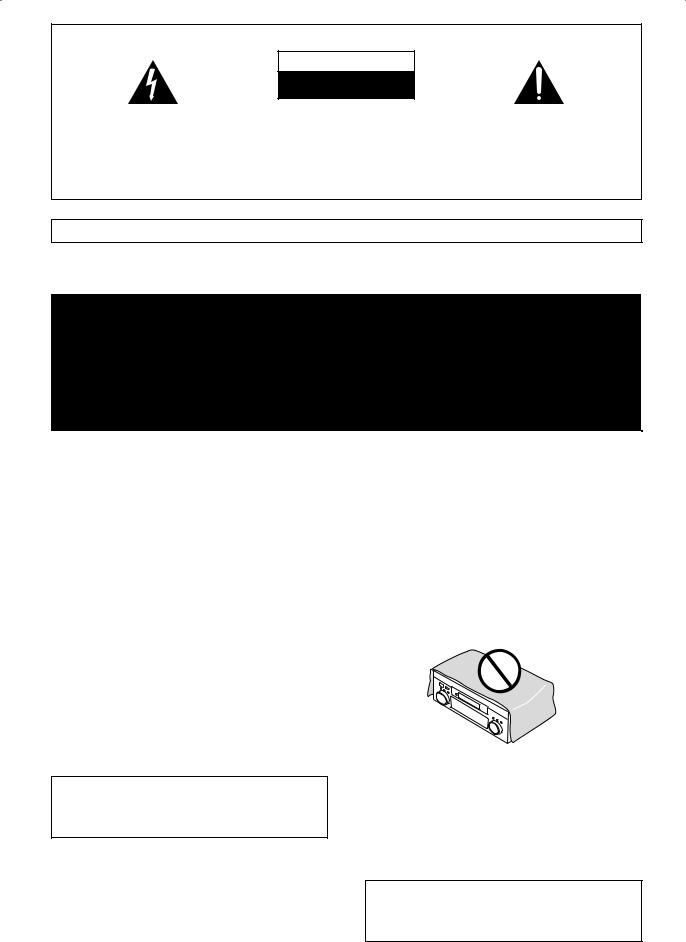
IMPORTANT
CAUTION
RISK OF ELECTRIC SHOCK
DO NOT OPEN
The lightning flash with arrowhead symbol, within an equilateral triangle, is intended to alert the user to the presence of uninsulated "dangerous voltage" within the product's enclosure that may be of sufficient magnitude to constitute a risk of electric shock to persons.
CAUTION:
TO PREVENT THE RISK OF ELECTRIC SHOCK, DO NOT REMOVE COVER (OR BACK). NO USER-SERVICEABLE PARTS INSIDE. REFER SERVICING TO QUALIFIED SERVICE PERSONNEL.
The exclamation point within an equilateral triangle is intended to alert the user to the presence of important operating and maintenance (servicing) instructions in the literature accompanying the appliance.
D3-4-2-1-1_En-A
NOTE: THE NO USER-SERVICEABLE PARTS COMPARTMENT WARNING IS LOCATED ON THE APPLIANCE BONNET
Replacement and mounting of an AC plug on the power supply cord of this unit should be performed only by qualified service personnel.
IMPORTANT
FOR USE IN THE UNITED KINGDOM
The wires in this mains lead are coloured in accordance with the following code:
Blue : Neutral Brown : Live
If the plug provided is unsuitable for your socket outlets, the plug must be cut off and a suitable plug fitted.
The cut-off plug should be disposed of and must not be inserted into any 13 amp socket as this can result in electric shock. The plug or adaptor or the distribution panel should be provided with 10 A fuse. As the colours of the wires in the mains lead of this appliance may not correspond with coloured markings identifying the terminals in your plug, proceed as follows ;
The wire which is coloured blue must be connected to the terminal which is marked with the letter N or coloured black.
The wire which is coloured brown must be connected to the terminal which is marked with the letter L or coloured red.
Do not connect either wire to the earth terminal of a three pin plug.
NOTE
After replacing or changing a fuse, the fuse cover in the plug must be replaced with a fuse cover which corresponds to the colour of the insert in the base of the plug or the word that is embossed on the base of the plug, and the appliance must not be used without a fuse cover. If lost replacement fuse covers can be obtained from your dealer.
Only 10 A fuses approved by B.S.I or A.S.T.A to B.S.1362 should be used.
D3-4-2-1-2-2_En
Thank you for buying this Pioneer product. Please read through these operating instructions so you will know how to operate your model properly. After you have finished reading the instructions, put them away in a safe place for future reference.
WARNING
Before plugging in for the first time, read the following section carefully.
The voltage of the available power supply differs according to country or region. Be sure that the power supply voltage of the area where this unit will be used meets the required voltage (e.g., 230V or 120V) written on the rear panel.
WARNING
To prevent a fire hazard, do not place any naked flame sources (such as a lighted candle) on the equipment.
This product complies with the Low Voltage Directive (73/23/EEC, amended by 93/68/EEC), EMC Directives (89/336/EEC, amended by 92/31/EEC and 93/68/EEC).
WARNING
This equipment is not waterproof. To prevent a fire or shock hazard, do not place any container filed with liquid near this equipment (such as a vase or flower pot) or expose it to dripping, splashing, rain or moisture.
VENTILATION CAUTION
When installing this unit, make sure to leave space around the unit for ventilation to improve heat radiation (at least 60 cm at top, 10 cm at rear, and 30 cm at each side).
WARNING
Slots and openings in the cabinet are provided for ventilation to ensure reliable operation of the product, and to protect it from overheating. To prevent fire hazard, the openings should never be blocked or covered with items (such as newspapers, table-cloths, curtains) or by operating the equipment on thick carpet or a bed.
Operating Environment
Operating environment temperature and humidity: +5 ºC – +35 ºC (+41 ºF – +95 ºF); less than 85 %RH (cooling vents not blocked)
Do not install this unit in a poorly ventilated area, or in locations exposed to high humidity or direct sunlight (or strong artificial light)
When disposing of used batteries, please comply with governmental regulations or environmental public instruction’s rules that apply in your country/area.

NOTE: This equipment has been tested and found to comply with the limits for a Class B digital device, pursuant to Part 15 of the FCC Rules. These limits are designed to provide reasonable protection against harmful interference in a residential installation. This equipment generates, uses, and can radiate radio frequency energy and, if not installed and used in accordance with the instructions, may cause harmful interference to radio communications. However, there is no guarantee that interference will not occur in a particular installation. If this equipment does cause harmful interference to radio or television reception, which can be determined by turning the equipment off and on, the user is encouraged to try to correct the interference by one or more of the following measures:
–Reorient or relocate the receiving antenna.
–Increase the separation between the equipment and receiver.
–Connect the equipment into an outlet on a circuit different from that to which the receiver is connected.
– Consult the dealer or an experienced radio/TV technician for help. |
D8-10-1-2_En |
Information to User
Alteration or modifications carried out without appropriate authorization may invalidate the user’s right to operate the equipment.
CAUTION: This product satisfies FCC regulations when shielded cables and connectors are used to connect the unit to other equipment. To prevent electromagnetic interference with electric appliances such as radios and televisions, use shielded cables and connectors for connections.
If the AC plug of this unit does not match the AC outlet you want to use, the plug must be removed and appropriate one fitted. Replacement and mounting of an AC plug on the power supply cord of this unit should be performed only by qualified service personnel. If connected to an AC outlet, the cut-off plug can cause severe electrical shock. Make sure it is properly disposed of after removal.
The equipment should be disconnected by removing the mains plug from the wall socket when left unused for a long period of time (for example, when on vacation).
Voltage selector
You can find the voltage selector switch on the rear panel of multi-voltage models.
The factory setting for the voltage selector is 220V. Please set it to the correct voltage for your country or region.
•Saudi Arabia operates on 127V and 220V mains voltage. Please set to the correct voltage before using.
•For Taiwan, please set to 110V before using.
•For Mexico, please set to 120-127V before using.
Before changing the voltage, disconnect the AC power cord. Use a medium size screwdriver to change the voltage selector switch.
TWO VOLTAGE SELECTORS
220V |
230- |
||
|
|
|
240 V |
110V |
120-127 V |
||
|
|
|
|
110V |
|
|
220V |
|
|
||
120-127V |
230-240V |
||
CAUTION
The OFF ON and STANDBY/ON buttons on this unit will not completely shut off all power from the AC outlet. Since the power cord serves as the main disconnect device for the unit, you will need to unplug it from the AC outlet to shut down all power. Therefore, make sure the unit has been installed so that the power cord can be easily unplugged from the AC outlet in case of an accident. To avoid fire hazard, the power cord should also be unplugged from the AC outlet when left unused for a long
period of time (for example, when on vacation). D3-4-2-
2-2a_A_En
This product is for general household purposes. Any failure due to use for other than household purposes (such as long-term use for business purposes in a restaurant or use in a car or ship) and which requires repair will be charged for even during the warranty period.
Important information about this unit‘s AC outlet (switched total 100W MAX)
Power supplied through these outlets is turned on and off by this unit’s OFF ON and
STANDBY/ON buttons. Total electrical power consumption of connected equipment should not exceed 100W.
CAUTION
•Do not connect a TV set, monitor, heater or similar appliance to this unit’s AC outlet.
•Do not connect appliances with high power consumption to the AC outlet in order to avoid overheating and fire risk. This can cause this unit
to malfunction.
D3-4-2-1-5_En

Contents
01 Before you start
Features . . . . . . . . . . . . . . . . . . . . . . . . . . . . . . . . . . . 6
Checking the supplied accessories . . . . . . . . . . . . . . 6
Installing the receiver . . . . . . . . . . . . . . . . . . . . . . . . . 7 Opening the front panel . . . . . . . . . . . . . . . . . . . . . . . 7 Using the remote control . . . . . . . . . . . . . . . . . . . . . . 7 Loading the batteries . . . . . . . . . . . . . . . . . . . . . . . . 7
Operating range of the remote control . . . . . . . . . . . 8
02 5 minute guide
Introduction to home theater . . . . . . . . . . . . . . . . . . . 9 Setting up for Surround Sound. . . . . . . . . . . . . . . . . . 9 Automatically setting up for surround sound . . . . . . 12
Other problems when using the Auto Surround Setup . . . . . . . . . . . . . . . . . . . . . . . . . . . . . . . . . . . 14
Checking the settings on your DVD (or other)
player . . . . . . . . . . . . . . . . . . . . . . . . . . . . . . . . . . . . 14 Playing a source . . . . . . . . . . . . . . . . . . . . . . . . . . . . 14
03 Connecting your equipment
Rear panel . . . . . . . . . . . . . . . . . . . . . . . . . . . . . . . . 15 About the video converter. . . . . . . . . . . . . . . . . . . . . 16 About cable types . . . . . . . . . . . . . . . . . . . . . . . . . . . 17 Analog audio cables. . . . . . . . . . . . . . . . . . . . . . . . 17 Digital audio cables . . . . . . . . . . . . . . . . . . . . . . . . 17 Video cables. . . . . . . . . . . . . . . . . . . . . . . . . . . . . . 17
When making cable connections . . . . . . . . . . . . . . 17
Connecting your TV . . . . . . . . . . . . . . . . . . . . . . . . . 18 Connecting a DVD player . . . . . . . . . . . . . . . . . . . . . 19
Connecting the multichannel analog outputs . . . . 20 Connecting a satellite/cable receiver or other
set-top box . . . . . . . . . . . . . . . . . . . . . . . . . . . . . . . . 21
Connecting a VCR or DVD recorder . . . . . . . . . . . . . 22 Connecting other video sources . . . . . . . . . . . . . . . . 23 Using the component video jacks. . . . . . . . . . . . . . . 24 Connecting digital audio sources . . . . . . . . . . . . . . . 25 Connecting analog audio sources . . . . . . . . . . . . . . 26 Connecting a component to the front panel inputs. . 27 Installing your speaker system . . . . . . . . . . . . . . . . . 28
Connecting the speakers . . . . . . . . . . . . . . . . . . . . 29 Placing the speakers . . . . . . . . . . . . . . . . . . . . . . . 29 Connecting antennas . . . . . . . . . . . . . . . . . . . . . . . . 30 AM loop antenna . . . . . . . . . . . . . . . . . . . . . . . . . . 30 FM wire antenna . . . . . . . . . . . . . . . . . . . . . . . . . . 30
Connecting external antennas . . . . . . . . . . . . . . . . 30
Plugging in the receiver . . . . . . . . . . . . . . . . . . . . . . 31 About the AC outlet . . . . . . . . . . . . . . . . . . . . . . . . 31
4
04 Controls and displays
Front panel . . . . . . . . . . . . . . . . . . . . . . . . . . . . . . . . 32 Display . . . . . . . . . . . . . . . . . . . . . . . . . . . . . . . . . . . 35 Remote control. . . . . . . . . . . . . . . . . . . . . . . . . . . . . 36
05 Listening to your system
Auto playback. . . . . . . . . . . . . . . . . . . . . . . . . . . . . . 38
Listening in surround sound. . . . . . . . . . . . . . . . . . . 38 The MOVIE listening modes . . . . . . . . . . . . . . . . . . 39 The MUSIC listening modes . . . . . . . . . . . . . . . . . . 40 Dolby Pro Logic IIx Music settings . . . . . . . . . . . . . 40 Adjusting the advanced effect level . . . . . . . . . . . . 41
Listening in stereo . . . . . . . . . . . . . . . . . . . . . . . . . . 41
Listening with headphones. . . . . . . . . . . . . . . . . . . . 41 Using the multichannel analog inputs . . . . . . . . . . . 42 Listening with Acoustic Calibration EQ. . . . . . . . . . . 42 Selecting the input signal type . . . . . . . . . . . . . . . . . 43 Using the surround back channel . . . . . . . . . . . . . . 44 Listening with virtual surround back speakers . . . . . 45 Using the audio scaler for Hi-bit and Hi-sampling . . 45 Using Midnight and Loudness listening . . . . . . . . . . 46
Using the tone control . . . . . . . . . . . . . . . . . . . . . . . 46
Switching the tone control on or off . . . . . . . . . . . . 46 Adjusting the bass and treble . . . . . . . . . . . . . . . . 46 Reducing noise during playback. . . . . . . . . . . . . . . . 47 Listening to dual mono soundtracks. . . . . . . . . . . . . 47
06 Using the tuner
Finding a station. . . . . . . . . . . . . . . . . . . . . . . . . . . . 48
Tuning directly to a station . . . . . . . . . . . . . . . . . . . . 48
MPX mode . . . . . . . . . . . . . . . . . . . . . . . . . . . . . . . 49
Memorizing station presets . . . . . . . . . . . . . . . . . . . 49 Listening to memorized station presets . . . . . . . . . 50
Naming station presets . . . . . . . . . . . . . . . . . . . . . 50 An introduction to RDS . . . . . . . . . . . . . . . . . . . . . . 51
Displaying RDS information. . . . . . . . . . . . . . . . . . 51 Searching for RDS programs . . . . . . . . . . . . . . . . . 52
An introduction to EON . . . . . . . . . . . . . . . . . . . . . . 52 Using EON . . . . . . . . . . . . . . . . . . . . . . . . . . . . . . . 52
Clearing all stations from the RDS and EON searches . . . . . . . . . . . . . . . . . . . . . . . . . . . . . . . . 53
07 The Surround Setup menu
Making receiver settings from the Surround
Setup menu . . . . . . . . . . . . . . . . . . . . . . . . . . . . . . . 54
Surround back speaker setting. . . . . . . . . . . . . . . . . 55
Normal surround setting . . . . . . . . . . . . . . . . . . . . . 55 Speaker Setting . . . . . . . . . . . . . . . . . . . . . . . . . . . 55 Channel Level. . . . . . . . . . . . . . . . . . . . . . . . . . . . . 56 Speaker Distance . . . . . . . . . . . . . . . . . . . . . . . . . . 57
En

08 Controlling other equipment |
11 Advanced setup |
Using the remote control with other
components. . . . . . . . . . . . . . . . . . . . . . . . . . . . . . . 58 Recalling preset codes . . . . . . . . . . . . . . . . . . . . . . 58
Programming signals from other remote
controls . . . . . . . . . . . . . . . . . . . . . . . . . . . . . . . . . . 59 Controls for TVs . . . . . . . . . . . . . . . . . . . . . . . . . . . . 60
Controls for other components . . . . . . . . . . . . . . . . 61
Direct function. . . . . . . . . . . . . . . . . . . . . . . . . . . . . 63
Multi Operation and System Off. . . . . . . . . . . . . . . . 63 Programming a multi-operation or a shutdown sequence. . . . . . . . . . . . . . . . . . . . . . . . . . . . . . . . 63 Using multi operations . . . . . . . . . . . . . . . . . . . . . 64 Using System off . . . . . . . . . . . . . . . . . . . . . . . . . . 65
Switching components on and off using the
12 volt trigger. . . . . . . . . . . . . . . . . . . . . . . . . . . . . . 65
Operating other Pioneer components with this
unit’s sensor . . . . . . . . . . . . . . . . . . . . . . . . . . . . . . 65
The System Setup menu . . . . . . . . . . . . . . . . . . . . . 80 THX CINEMA Setup. . . . . . . . . . . . . . . . . . . . . . . . 81 The Input Assign menu . . . . . . . . . . . . . . . . . . . . . 81 Function Rename . . . . . . . . . . . . . . . . . . . . . . . . . 83 SACD Setup . . . . . . . . . . . . . . . . . . . . . . . . . . . . . 84 PHONO/LINE Setup . . . . . . . . . . . . . . . . . . . . . . . 84
Multi-Room and IR receiver setup . . . . . . . . . . . . . 85
12 Volt Trigger . . . . . . . . . . . . . . . . . . . . . . . . . . . . 85 The Expert setup menu . . . . . . . . . . . . . . . . . . . . . . 86 Crossover Network . . . . . . . . . . . . . . . . . . . . . . . . 87 Fine Channel Level . . . . . . . . . . . . . . . . . . . . . . . . 87 Fine Channel Delay . . . . . . . . . . . . . . . . . . . . . . . . 88 Acoustic Calibration EQ . . . . . . . . . . . . . . . . . . . . 88
Professional Acoustic Calibration . . . . . . . . . . . . . 91 Using Professional Acoustic Calibration . . . . . . . . 92
Bass Peak Level . . . . . . . . . . . . . . . . . . . . . . . . . . 93 Dynamic Range Control . . . . . . . . . . . . . . . . . . . . 94
09 Using other functions
Making an audio or a video recording . . . . . . . . . . . 66 Adjusting the delay of a soundtrack. . . . . . . . . . . . . 66 Watching video and audio sources independently . . 67 Enhancing SACD playback . . . . . . . . . . . . . . . . . . . 67
Dimming the display . . . . . . . . . . . . . . . . . . . . . . . . 67
Switching the speaker impedance . . . . . . . . . . . . . . 68 Advanced remote control features . . . . . . . . . . . . . . 68 Editing remote control display names . . . . . . . . . . 68 Adjusting the remote control backlight . . . . . . . . . 69 Clearing remote control settings . . . . . . . . . . . . . . 69
Resetting the system . . . . . . . . . . . . . . . . . . . . . . . . 70
10 Other connections
Second Zone speaker B setup . . . . . . . . . . . . . . . . . 71 Switching the speaker system . . . . . . . . . . . . . . . . 71 Bi-amping your front speakers . . . . . . . . . . . . . . . . . 72
Bi-wiring your speakers . . . . . . . . . . . . . . . . . . . . . . 72 Multi-room listening . . . . . . . . . . . . . . . . . . . . . . . . 73
Making multi-room connections . . . . . . . . . . . . . . 73 Using the multi-room controls. . . . . . . . . . . . . . . . 74 Connecting an IR receiver . . . . . . . . . . . . . . . . . . . . 75 Connecting additional amplifiers . . . . . . . . . . . . . . . 75 Using the i.LINK interface . . . . . . . . . . . . . . . . . . . . 76
About i.LINK . . . . . . . . . . . . . . . . . . . . . . . . . . . . . . 77 About PQLS rate control . . . . . . . . . . . . . . . . . . . . 77
Creating an i.LINK network . . . . . . . . . . . . . . . . . . 77
Using the USB interface . . . . . . . . . . . . . . . . . . . . . 78
Connecting a PC for Advanced MCACC output . . . . 79 Advanced MCACC output using your PC. . . . . . . . 79
12 Additional information |
|
Troubleshooting. . . . . . . . . . . . . . . . . . . . . . . . . . . |
. 95 |
Power . . . . . . . . . . . . . . . . . . . . . . . . . . . . . . . . . . |
95 |
No sound . . . . . . . . . . . . . . . . . . . . . . . . . . . . . . . |
96 |
Other audio problems . . . . . . . . . . . . . . . . . . . . . . |
97 |
Video . . . . . . . . . . . . . . . . . . . . . . . . . . . . . . . . . . . |
98 |
Settings. . . . . . . . . . . . . . . . . . . . . . . . . . . . . . . . . |
99 |
Display . . . . . . . . . . . . . . . . . . . . . . . . . . . . . . . . . |
99 |
Remote control . . . . . . . . . . . . . . . . . . . . . . . . . . |
100 |
i.LINK interface . . . . . . . . . . . . . . . . . . . . . . . . . . |
101 |
i.LINK messages . . . . . . . . . . . . . . . . . . . . . . . . . |
101 |
USB interface . . . . . . . . . . . . . . . . . . . . . . . . . . . |
102 |
Changing the frequency step. . . . . . . . . . . . . . . . . |
102 |
Maintenance of external surfaces . . . . . . . . . . . . . |
102 |
Surround sound formats . . . . . . . . . . . . . . . . . . . . |
103 |
Dolby. . . . . . . . . . . . . . . . . . . . . . . . . . . . . . . . . . |
103 |
DTS . . . . . . . . . . . . . . . . . . . . . . . . . . . . . . . . . . . |
103 |
About THX . . . . . . . . . . . . . . . . . . . . . . . . . . . . . . . |
104 |
Preset code brands . . . . . . . . . . . . . . . . . . . . . . . . |
105 |
Specifications (European model) . . . . . . . . . . . . . . |
106 |
Specifications (Multi-voltage model) . . . . . . . . . . . |
107 |
5
En
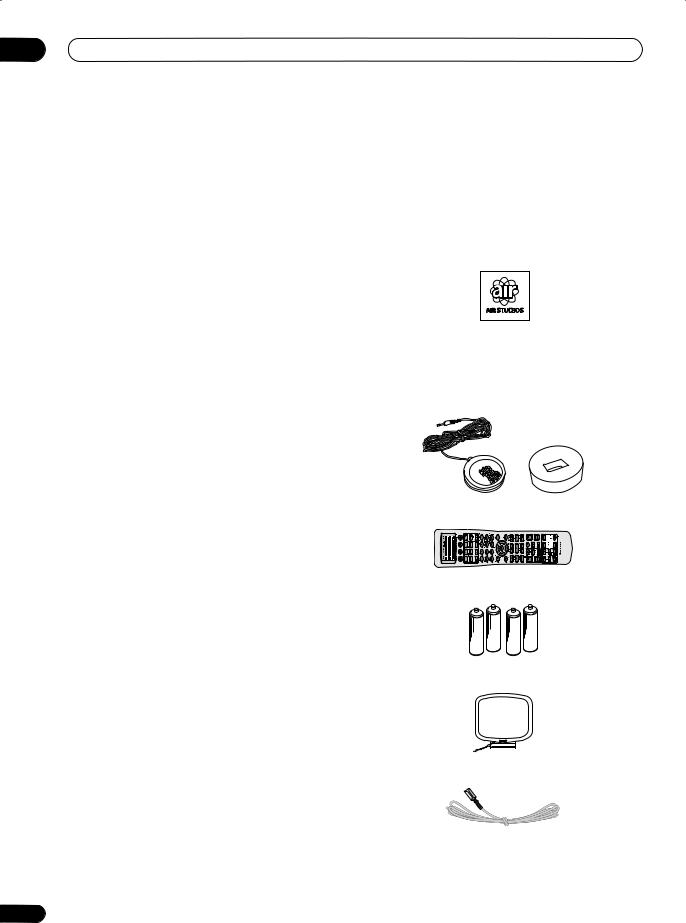
01 Before you start
Chapter 1
Before you start
Features
• Easy setup using Advanced Multichannel Acoustic Calibration (MCACC)
Setting up for home theater sound is as easy as connecting your speakers, a DVD player or other source, and your TV. The Auto Surround Setup provides a quick but accurate surround sound setup, while for complete surround sound control you still have access to the full range of surround sound settings.
In addition, the Professional Acoustic Calibration setup measures the reverb characteristics of your listening area, allowing you to customize your system calibration with the help of a graphical output that can be displayed on-screen, or using a computer.
•i.LINK digital interface
The i.LINK interface makes it possible to connect this receiver to i.LINK-equipped components, allowing you to enjoy high sampling rate (up to 192kHz) PCM multichannel digital audio from DVD-Audio and SACD discs, as well as digital audio from DVD-Video, CD and Video CD discs, all with a single cable.
With SACD discs, you will also be able to bypass the signal processing of this receiver to hear 1-bit Direct Stream Digital (DSD) audio directly.
• Dolby Digital and DTS decoding, including Dolby Digital EX, DTS 96/24 and DTS-ES
Dolby Digital and DTS decoding brings theater sound right into your home with up to six channels of surround sound, including a special LFE (Low Frequency Effects) channel for deep, realistic sound effects.
The built-in Dolby Pro Logic IIx and DTS Neo:6 decoders not only provide full surround sound decoding for Dolby Surround sources, but will also generate convincing surround sound for any stereo source.
Also, with the addition of a surround back speaker, you can take advantage of the built-in Dolby Digital EX and DTS-ES decoders for six-channel surround sound.
•Seamless video conversion
With the Pioneer video converter, you can use a wide range of cables interchangeably, giving you more flexibility when making video connections.
•USB digital interface
It is possible to listen to audio sources from your computer by connecting to the USB interface on the rear of this receiver.
6
•Fine-tuned to world-class standards
With the cooperation of the world-class studio engineers at AIR Studios, this receiver amplifier has been designated AIR Studios Monitor.
Checking the supplied accessories
Please check that you've received the following supplied accessories:
• Setup microphone and stand
•Remote control unit
•Alkaline batteries (AA IEC LR6) x 4
•AM loop antenna
• FM wire antenna
En
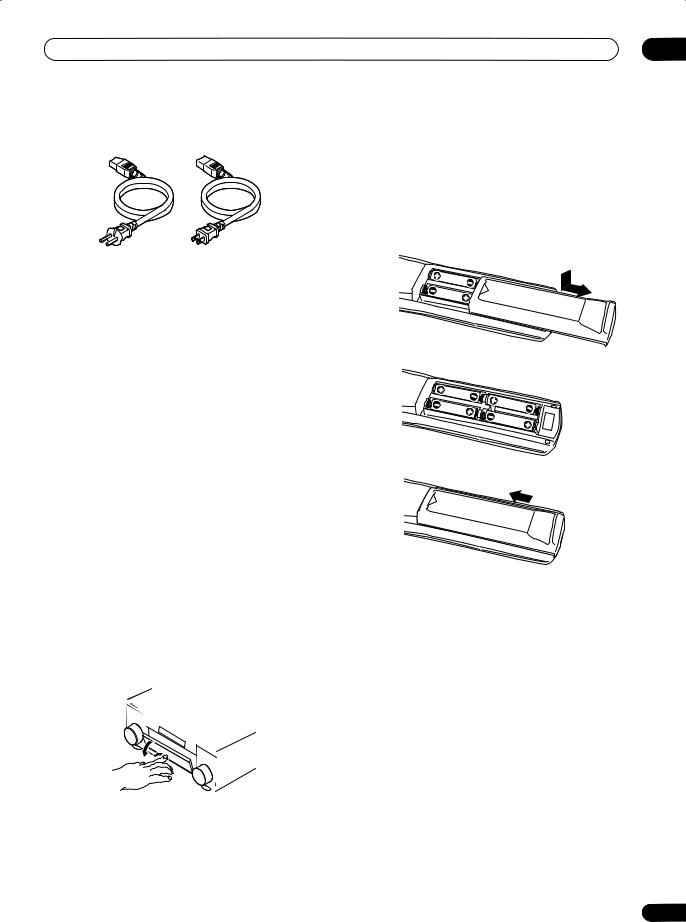
Before you start
• Power cord x 1 (Multi-voltage NTSC model x 2)
All models |
NTSC model only |
•Flat-bladed adapter (Multi-voltage model only)
•Antenna converter (Multi-voltage model only)
•These operating instructions
 Note
Note
•The accessories will be different depending on the country of purchase. Where two power cords are included, make sure to use the cord appropriate for your country or region.
Installing the receiver
•When installing this unit, make sure to put it on a level and stable surface.
Don’t install it on the following places:
–on a color TV (the screen may distort)
–near a cassette deck (or close to a device that gives off a magnetic field). This may interfere with the sound.
–in direct sunlight
–in damp or wet areas
–in extremely hot or cold areas
–in places where there is vibration or other movement
–in places that are very dusty
–in places that have hot fumes or oils (such as a kitchen)
Opening the front panel
To open the front panel, push gently on the lower third of the panel with your finger.
01
Using the remote control
Loading the batteries
Load the batteries into the remote control as shown below using alkaline batteries (AA IEC LR6) batteries. When you notice a decrease in the operating range, replace all batteries with new ones.
 Caution
Caution
Incorrect use of batteries can result in hazards such as leakage and bursting. Please observe the following:
•Don’t mix new and old batteries together.
•Don’t use different kinds of batteries together— although they may look similar, different batteries may have different voltages.
•Make sure that the plus and minus ends of each battery match the indications in the battery compartment.
•Remove batteries from equipment that isn’t going to be used for a month or more.
•When disposing of used batteries, please comply with governmental regulations or environmental public instruction’s rules that apply in your country or area.
H048 En
7
En
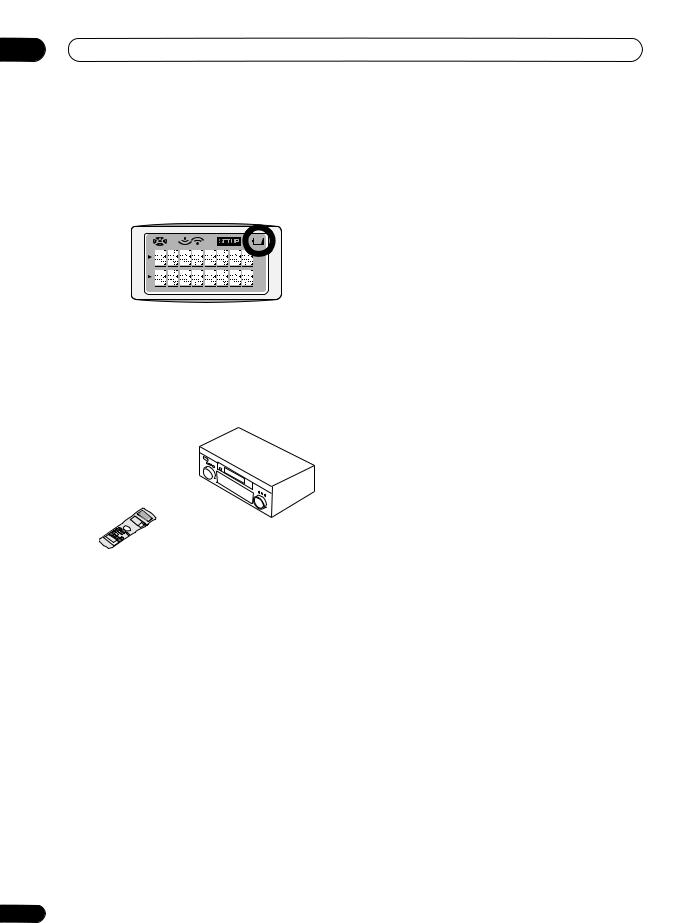
01 Before you start
Remote control battery indicator
When the batteries get too weak to operate the remote control properly an indicator warning screen will appear on the remote. Change the batteries as shown above. This must be done within five minutes or all your remote control settings will be cleared.
Operating range of the remote control
The operating range is quite large, but please keep in mind the following when using the remote control:
•Make sure that there are no obstacles between the remote and the remote sensor on the unit.
•The remote has a range of about 7 meters.
30 

30
7m
•Remote operation may become unreliable if strong sunlight or fluorescent light is shining on the unit’s remote sensor.
•Remote controllers for different devices can interfere with each other. Avoid using remotes for other equipment located close to this unit.
8
En
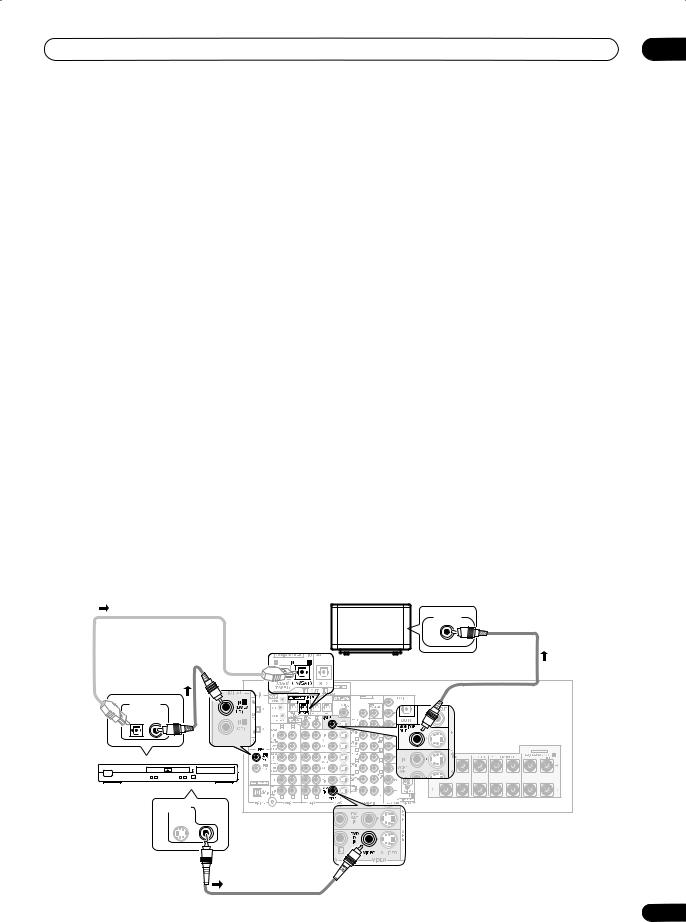
5 minute guide |
02 |
Chapter 2:
5 minute guide
Introduction to home theater
You are probably used to using stereo equipment to listen to music, but may not be used to home theater systems that give you many more options (such as surround sound) when listening to soundtracks.
Home theater refers to the use of multiple audio tracks to create a surround sound effect, making you feel like you're in the middle of the action or concert. The surround sound you get from a home theater system depends not only on the speakers you have set up in your room, but also on the source and the sound settings of the receiver.
DVD-Video has become the basic source material for home theater due to its size, quality, and ease of use. Depending on the DVD, you can have up to seven different audio tracks coming from one disc, all of them being sent to different speakers in your system. This is what creates a surround sound effect and gives you the feeling of ‘being there’.
This receiver will automatically decode Dolby Digital, DTS, or Dolby Surround DVD-Video discs, according to your speaker setup. In most cases, you won’t have to make changes for realistic surround sound, but other possibilities (like listening to a CD with multichannel surround sound) are explained in Listening to your system on page 38.
Setting up for Surround Sound
This receiver was designed with the easiest possible setup in mind, so with the following quick setup guide, you should have your system hooked up for surround sound in no time at all. In most cases, you can simply leave the receiver in the default settings.
Be sure to complete all connections before connecting this unit to the AC power source.
1 Hook up your DVD player.
For surround sound, you’ll want to hook up using a digital connection from the DVD player to the receiver. You can do this with either a coaxial, or an optical connection (you don’t need to connect both). If you hook up using an optical cable, you should refer to The Input Assign menu on page 81 to assign the optical input to DVD/LD.
Use a standard RCA video cable to connect your DVD player video output to the receiver using the jacks shown below.
2 Hook up your TV.
Use a standard RCA video cable to connect your receiver to the TV using the jacks as shown below.
Optical cable |
VIDEO IN |
|
|
|
TV |
|
Standard RCA |
Coaxial digital |
video cable |
audio cable |
|
DIGITAL OUT |
CENTER |
|
CE |
|
S400 |
|
S400 |
|
SELECTABLE |
DVD player |
|
VIDEO OUT |
|
S |
|
|
Standard RCA |
|
video cable |
9
En
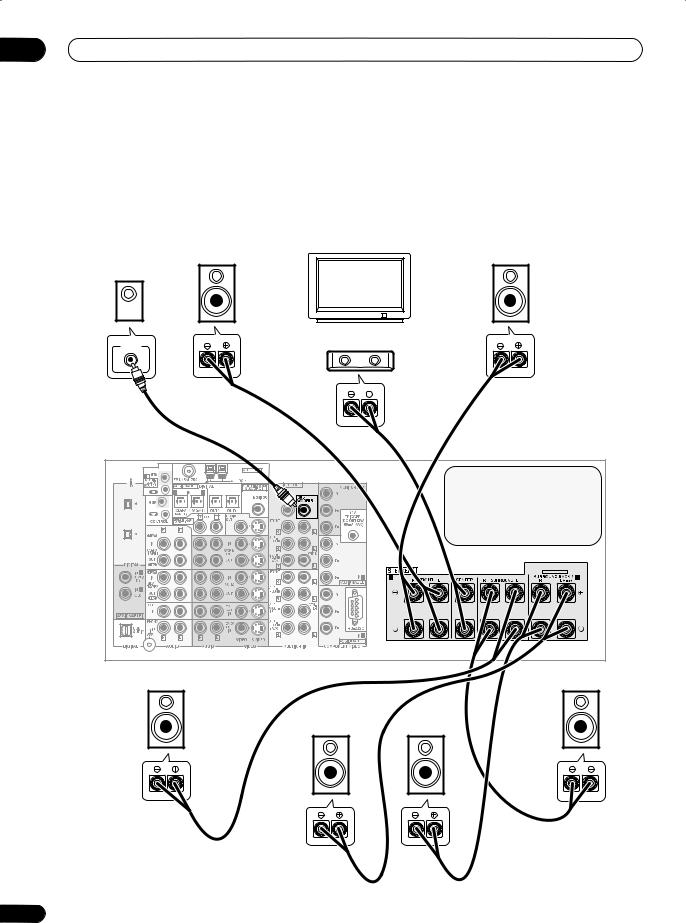
02 5 minute guide
3 Connect your speakers.
To take full advantage of the receiver’s surround sound capabilities connect front, center, surround and surround back speakers, as well as a subwoofer. Although this is ideal, other configurations with fewer speakers—no subwoofer or no center speaker, or even no surround speakers—will work. At the very least, front left and right speakers only are necessary. Note that your main surround speakers should always be connected as a pair, but you can connect just one surround back speaker if you like (it must be connected to the left surround back terminal).
You can use speakers with a nominal impedance between 6–16Ω (please see Switching the speaker impedance on page 68 if you plan to use speakers with an impedance of less than 8Ω).
Subwoofer |
Front |
Front |
|
left |
right |
|
|
TV |
LINE LEVEL |
|
Center |
INPUT |
|
|
 CENTER
CENTER
S400
S400
 Caution
Caution
These speaker terminals carry
HAZARDOUS LIVE voltage. To prevent the risk of electric shock when connecting or disconnecting the speaker cables, disconnect the power cord before touching any uninsulated parts.
SELECTABLE |
VSX-AX5Ai
Surround |
|
|
Surround |
left |
Surround |
Surround |
right |
|
back left |
back right |
|
10
En

5 minute guide |
02 |
Each speaker connection on the receiver comprises a positive (+) red, and negative (–) black terminal. For proper sound you should take care to match these up with the terminals on the speakers themselves.
•If you only have one surround back speaker, hook it up to the surround back left (Single) terminal.
•If you’re not using a subwoofer, change the front speaker setting (see Speaker Setting on page 55) to
LARGE.
 Caution
Caution
•Make sure that all the bare speaker wire is twisted together and inserted fully into the speaker terminal. If any of the bare speaker wire touches the back panel it may cause the power to cut off as a safety measure.
Make sure that the speaker cable you’re going to use is properly prepared with about 10 mm of insulator stripped from each wire, and the exposed wire strands twisted together (fig. A).
To connect a terminal, unscrew the terminal a few turns until there is enough space to insert the exposed wire (fig. B). Once the wire is in position, tighten the terminal until the wire is firmly clamped (fig. C).
10mm
4 Plug in the receiver and switch it on, followed by your DVD player, your subwoofer and the TV.
Make sure you’ve set the video input on your TV to this receiver. Check the manual that came with the TV if you don’t know how to do this.
Also make sure that DVD/LD is showing in the receiver’s display, indicating that the DVD input is selected. If it isn’t, press DVD/LD on the remote control to set the receiver to the DVD input.
5Use the on-screen Auto Surround setup to set up your system.
See Automatically setting up for surround sound on the next page for more on this.
6Play a DVD, and adjust the volume to your liking.
In addition to the basic playback explained in Playing a source on page 14, there are several other sound options you can select. See Listening to your system on page 38 for more on this. See also Making receiver settings from the Surround Setup menu on page 54 for more setup options.
•If you’re not familiar with the proper DVD settings, refer to Checking the settings on your DVD (or other) player on page 14.
fig. A |
fig. B |
fig. C |
Where you place the speakers will have a big effect on the sound. Place your speakers as shown below for the best surround sound effect. For more tips on speaker placement, see Placing the speakers on page 29.
Front L |
Front R |
Sub- |
|
woofer |
|
|
Center |
Surround |
Surround |
L |
R |
Surround |
Surround |
back L |
back R |
11
En
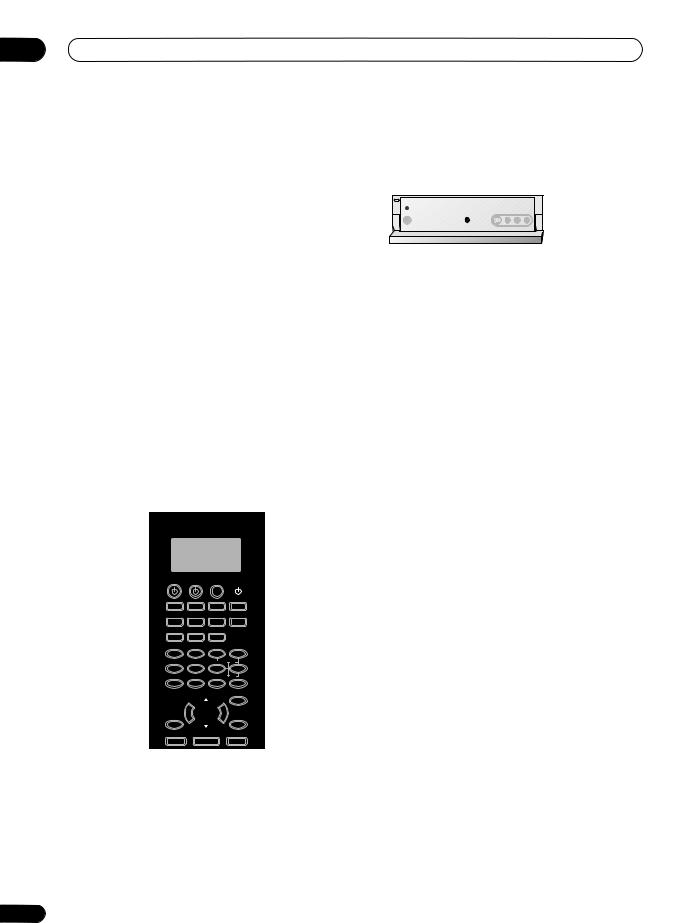
02 5 minute guide
Automatically setting up for surround sound
The Auto Surround Setup measures the acoustic characteristics of your listening area, taking into account ambient noise, speaker size and distance, and tests for both channel delay and channel level. After you have set up the microphone provided with your system, the receiver uses the information from a series of test tones to optimize the speaker settings and equalization for your particular room.
Make sure you do this before moving on to Playing a source on page 14.
 Important
Important
•Make sure the microphone and speakers are not moved during the Auto Surround Setup.
•Using the Auto Surround Setup will overwrite any existing speaker settings in the receiver.
•The receiver will automatically exit the on-screen menu after three minutes of inactivity.
 Caution
Caution
•The test tones used in the Auto Surround Setup are output at high volume.
RECEIVER
RECEIVER
SYSTEM SETUP
ENTER
1 Switch on the receiver and your TV.
Use the OFF ON button to turn on the power, then press the RECEIVER button to switch on.
12
2 Connect the microphone to the MCACC SETUP MIC jack on the front panel.
Make sure there are no obstacles between the speakers and the microphone.
•Place the microphone on the supplied microphone stand (shown above) for the best results with the Auto Surround Setup.
 Important
Important
•If you have a tripod, use it to place the microphone so that it’s about ear level at your normal listening position. Otherwise, place the microphone at ear level using a table or a chair.
3Press RECEIVER on the remote control, then press the SYSTEM SETUP button.
An on-screen display (OSD) appears on your TV. Use the /(cursor up/down) buttons and ENTER on the remote control to navigate through the screens and select menu items.
4‘Surround Setup’ should be highlighted. Press ENTER.
System Setup |
|
|||
[ |
|
|
] |
|
1. Surround Setup |
||||
[ 2. THX CINEMA Setup ] |
||||
[ 3. Input Assign |
] |
|||
[ 4. Function Rename |
] |
|||
[ 5. |
SACD Setup |
] |
||
[ 6. |
PHONO/LINE Setup ] |
|||
[ 7. |
Multi Room |
] |
||
[ 8. |
12V Trigger |
] |
||
[ Exit |
] |
|||
|
|
|
|
|
5 ‘SurrBack System’ should be highlighted. Press ENTER.
1.Surround Setup
 [ SurrBack System ]
[ SurrBack System ]
[ Auto Setting |
] |
[ Normal |
] |
[ Expert |
] |
[ Exit |
] |
En
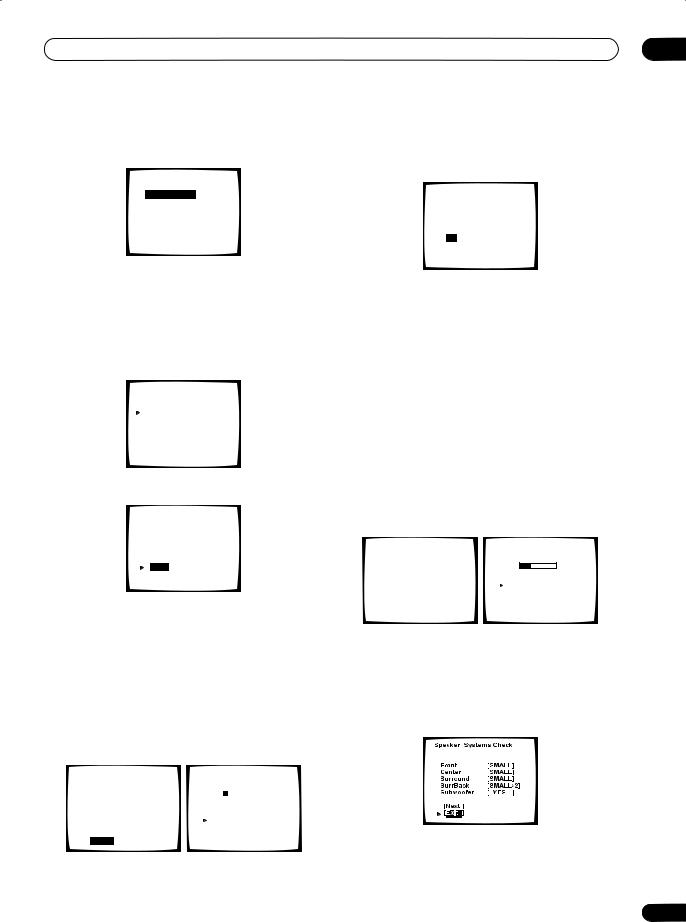
5 minute guide |
02 |
6 Make sure ‘Normal System’ is selected, then select ‘Exit’.
SurrBack System
 [ Normal System ]
[ Normal System ]
[ Second Zone |
] |
[ Front Bi-Amp |
] |
[ MR&S |
] |
[ Exit |
] |
10 Confirm the speaker configuration in the OSD.
The configuration shown on-screen should reflect the actual speakers you have.
Check!! |
|
|
Front |
[ YES |
] |
Center |
[ YES |
] |
Surround |
[ YES |
] |
SurrBack |
[ YESX2 ] |
|
Subwoofer |
[ YES |
] |
 [OK] [Retry]
[OK] [Retry]
[ERR Fix SP.] [Return to Menu]
Fix SP.] [Return to Menu]
•If you are planning on bi-amping your front speakers, or setting up a separate speaker system in another room, read through Surround back speaker setting on page 55 and make sure to connect your speakers as necessary before continuing to step 7.
7 ‘Auto Setting’ should be highlighted. Press ENTER.
1.Surround Setup
[ SurrBack System ]
[ |
Auto Setting |
] |
[ |
Normal |
] |
[ Expert |
] |
|
[ Exit |
] |
|
8 Follow the instructions on-screen.
Auto Surround Setup
 Set microphone
Set microphone
 Turn on subwoofer
Turn on subwoofer
If the speaker configuration displayed isn’t correct, use the /(cursor up/down) buttons to select Retry. Follow the instructions from step 8.
If the configuration is incorrect and you want to input the settings manually, select ERR Fix SP. Use /(cursor up/down) to select the speaker and to specify the size (and number for surround back). When you’re finished, go to the next step.
If you see an ERR message in the right side column, there may be a problem with the speaker connection. If selecting Retry (above) doesn’t fix the problem, turn off the power and check the speaker connections.
11 Make sure ‘OK’ is selected, then press ENTER.
A progress report is displayed on-screen while the receiver outputs more test tones to determine the optimum receiver settings for channel level, speaker distance, and acoustic calibration EQ.
Auto Surround Setup |
Auto Surround Setup |
Now Analyzing•••
[ Start |
] |
Please Wait |
|
Surround Analysis |
|
||
[ Cancel ] |
|
|
|||||
|
|
|
Speaker |
Systems |
[OK] |
||
|
|
Caution!! |
|
||||
|
|
|
Speaker Distance |
[OK] |
|||
|
|
Test |
tone is |
|
Channel |
Level |
[OK] |
|
|
|
output |
loudly. |
Acoustic |
Cal EQ |
[OK] |
•Make sure the microphone is connected.
•If you’re using a subwoofer, switch it on and turn up the volume.
•See below for notes regarding high background noise levels and other possible interference.
9 Make sure ‘Start’ is selected, then press ENTER.
A progress report is displayed on-screen while the receiver outputs test tones to determine the speakers present in your setup. Try to be as quiet as possible while it’s doing this.
Auto Surround |
Setup |
Auto Surround Setup |
|
|||||||
|
|
|
Now Analyzing••• |
|
||||||
Please Wait |
|
|
|
|
|
|
|
|
|
|
Environment Check |
|
|||||||||
Caution!! |
|
Ambient Noise |
[OK] |
|||||||
|
Microphone |
[OK] |
||||||||
Test tone is |
Speaker YES/NO |
[OK] |
||||||||
output |
loudly. |
[ |
|
|
] |
|
|
|
|
|
|
|
Cancel |
|
|
|
|
||||
[ Cancel ]
•Do not turn down the volume during the test tones. This may result in incorrect speaker settings.
[ |
Cancel |
] |
[ |
Cancel |
] |
Again, try to be as quiet as possible while this is happening.
12 The Auto Surround Setup has finished! Select ‘Exit’ to go back to the Surround Setup menu.
The MCACC indicator continues to light to show the surround settings are complete.
The settings made in the Auto Surround Setup should give you excellent surround sound from your system, but it is also possible to adjust these settings manually using the Surround Setup menu (starting on page 54).
13
En

02 5 minute guide
•If you are using THX Certified speakers, confirm that all speakers are set to SMALL in Speaker Setting on page 55, and that the Crossover Network on page 87 is set to 80Hz.
You can also choose to view all the settings by selecting Next. Press ENTER after you have finished checking each screen. When you’re finished, select Exit to go back to the Surround Setup menu.
 Note
Note
•If you leave a check screen for over three minutes, or if you select Cancel at any time during the Auto Surround Setup, the receiver automatically exits and no settings will be made.
•Remember to disconnect the microphone after you’ve finished the Auto Surround Setup.
Other problems when using the Auto Surround Setup
If the room environment is not optimal for the Auto Surround Setup (too much background noise, echo off the walls, obstacles blocking the speakers from the microphone) the final settings may be incorrect. Check for household appliances (air conditioner, fridge, fan, etc.), that may be affecting the environment and switch them off if necessary.
Some older TVs may interfere with the operation of the microphone. If this seems to be happening, switch off the TV when doing the Auto Surround Setup.
Checking the settings on your DVD (or other) player
Before continuing, you may want to check the digital audio output settings on your DVD player and digital satellite receiver.
• Check that your DVD player/satellite receiver is set to output Dolby Digital, DTS and 88.2/96kHz PCM (2 channel) audio.
If there is an option for MPEG audio, set this to convert the MPEG audio to PCM.
If you connected the multichannel analog outputs of the player to this receiver, make sure that the player is set to output multichannel analog audio.
 Note
Note
•Depending on your DVD player or source discs, you may only get digital 2 channel stereo and analog sound. In this case, select one of the surround listening modes (see Listening in surround sound on page 38 if you need to do this) if you want multichannel surround sound.
14
Playing a source
Here are the basic instructions for playing a source (such as a DVD disc) with your home theater system.
1Turn on the power of the playback component (for example a DVD player), your TV and subwoofer (if you have one).
•If your source is the TV’s built-in tuner, then switch to the channel you want to watch, otherwise make sure that the TV’s video input is set to this receiver. (For example, if you connected this receiver to the VIDEO 1 jacks on your TV, make sure that VIDEO 1 input is now selected.)
2If the receiver isn’t already on, switch on the power.
Use the OFF ON button to turn on the power, then press the RECEIVER button to switch on.
3Change the receiver input to the source you want to play.
You can use the front panel MULTI JOG dial or the dedicated MULTI CONTROL buttons on the remote control.
4Start playback of the DVD (or other component).
If you’re playing a Dolby Digital or DTS surround sound DVD disc, you should hear surround sound. If you are playing a stereo source, you will only hear sound from the front left/right speakers in the default listening mode.
•See also Listening to your system on page 38 for more information on different ways of listening to sources.
5Use the MASTER VOLUME control (front panel or remote) to adjust the volume level.
•Turn down the volume of your TV so that all the sound is coming from the speakers connected to this receiver.
 Note
Note
•For more detailed surround sound setup, see The Surround Setup menu on page 54.
En
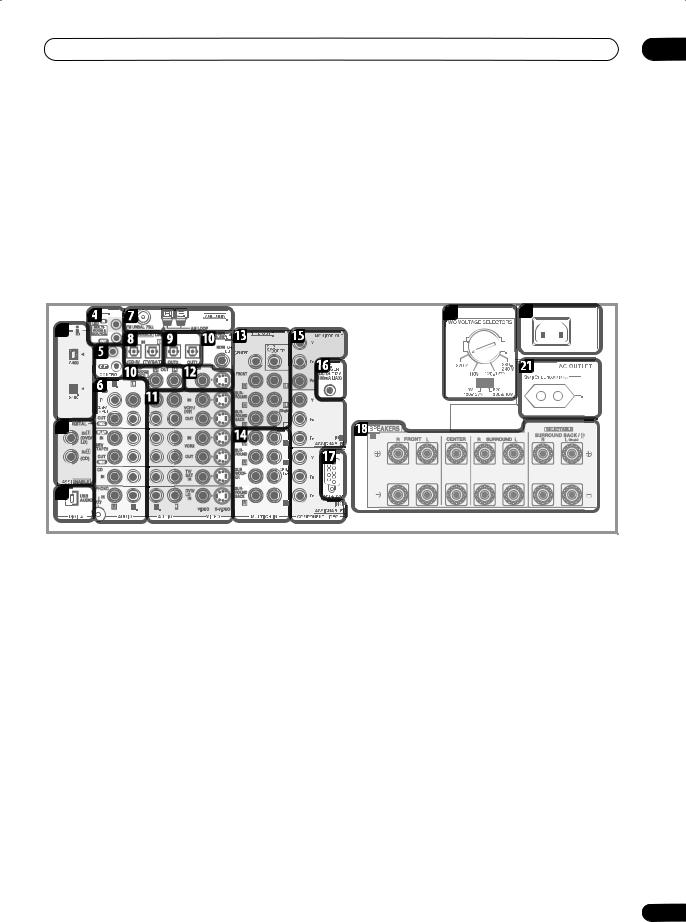
Connecting your equipment |
03 |
Chapter 3
Connecting your equipment
This receiver provides you with almost limitless possibilities for connecting your audio/video system, but it doesn’t have to be difficult. Depending on your needs, you could be up and running in no time after a few simple connections. This section has been designed so that you can read through this short introduction, then jump to the specific connections that you need to make. For a basic home theater setup, you may only need to look through the TV, DVD and speaker connections.
Rear panel
19 |
20 |
1
AC IN
 2
2 
 3
3
 Caution
Caution
•Before making or changing the connections, switch off the power and disconnect the power cord from the power outlet. Plugging in components should be the last connection you make with your system.
1 i.LINK connectors
Two S400-type i.LINK connectors allow you to connect this receiver to other compatible i.LINK audio devices for high-resolution, multichannel digital audio input/output. See Using the i.LINK interface on page 76 for connection details.
2 Digital audio coaxial inputs
Two coaxial digital audio inputs for connecting digital audio sources to this receiver. All the inputs are freely assignable to input functions for maximum flexibility.
•If a connected component does not correspond to the input function (DVD/LD, etc.), see Assigning the digital inputs on page 81 to assign it properly.
3 USB audio input
The USB audio input allows you to use your PC as a playback source for audio. See Using the USB interface on page 78 for connection details.
4 IR input/output
An IR connection allows you to connect an external remote control sensor, when your component system is in a closed cabinet or shelving unit, for example. See
Connecting an IR receiver on page 75 for connection details.
5 Control input/output
Mini-plug terminals for connection to other Pioneer components to enable you to control all your equipment from a single remote sensor. See Operating other Pioneer components with this unit’s sensor on page 65 for connection details.
6Stereo analog audio source inputs/outputs
Four sets of analog audio jacks for connection to audio sources such as CD players, tape decks and turntables. The CD-R/TAPE1 and MD/TAPE2 functions also feature outputs for recording. See Connecting analog audio sources on page 26 for connection details.
•The grounding ( ) terminal is for use with turntables that require it. See Connecting analog audio sources on page 26 for connection details.
7Antenna terminals
Connections for AM and FM radio antennas. See Connecting antennas on page 30 for connection details.
15
En

03 Connecting your equipment
8 Digital audio optical inputs
Two optical digital audio inputs for connecting digital audio sources to this receiver. All the inputs are freely assignable to input functions for maximum flexibility.
•If a connected component does not correspond to the input function (DVD/LD, etc.), see Assigning the digital inputs on page 81 to assign it properly.
9 Digital audio outputs
Two optical digital audio outputs for connecting to a CD- R, MD or other digital recorder. See Connecting digital audio sources on page 25 for connection details.
10 Multi-room and source outputs
The analog audio outputs are for connection to a second amplifier in a separate room. The MULTI-ROOM & SOURCE composite video output is for connection to a second monitor or TV in a separate room. See Multi-room listening on page 73.
11 Audio/video source inputs
Each of the six source input functions has stereo analog audio jacks, a composite video jack and an S-video jack for basic connections. On top of these, you can assign digital audio and component video jacks to input functions as necessary. As well as audio/video inputs, the two input functions VCR 1/DVR and VCR 2 also have audio/video outputs for recording. See Connecting a VCR or DVD recorder on page 22 for connection details.
12 Monitor video outputs
Two video outputs consisting of a standard composite video output and an S-video output, for connection to monitors and TVs. See Connecting your TV on page 18 for connection details.
13Multichannel pre-amplifier outputs
Multichannel pre-amp outputs that you can use to connect separate amplifiers for center, surround, surround back and subwoofer channels. See Connecting additional amplifiers on page 75 for connection details.
14Multichannel analog audio inputs
7.1 channel analog inputs for connection to a component with multichannel analog outputs. See Connecting the multichannel analog outputs on page 20 for connection details.
15 Component video inputs/output
The two component video inputs are freely assignable to any of the audio/video input functions. The component video output is for connection to a monitor or TV. See
Using the component video jacks on page 24 for connection details.
16 12V trigger jack
This terminal outputs DC 12V according to the input functions (100 mA max.). See Switching components on and off using the 12 volt trigger on page 65 for connection details.
16
17 RS-232C connector
This port is provided for connecting a personal computer for graphical output when using Advanced MCACC.
18 Speaker terminals
These are the main speaker terminals for front, center, surround and surround back speakers. See Installing your speaker system on page 28 for connection details.
19Voltage selector switches (Multi-voltage model only)
Use these to match the voltage coming into the receiver with the voltage in your country or region (see page 3 for more on this).
20AC power inlet
Connect the supplied power cord here.
21 AC power outlet Switched 100W max. (Continental European model only – Excluding UK)
This 230V AC power outlet can be used to power another component in your setup (up to 100 W). Power to this outlet is switched off when the receiver is in standby.
About the video converter
The video converter allows you to connect various video sources using composite, S-video or component video connections and the signal will be output through all of the MONITOR VIDEO OUT jacks. The only exception is component video input, which is only output from the component video output. Therefore, if you want to connect any source using component video, you must also connect your TV using component video. If several video components are connected to the same input function, the converter gives priority to component, S- video, then composite (in that order).
The following chart shows when the video signal will be converted from the various video inputs (left column) for output to the MONITOR VIDEO OUT jacks (top row):
Video terminal
VIDEO IN (Composite)
S-VIDEO IN
COMPONENT VIDEO IN
MONITOR OUT
VIDEO |
S-VIDEO |
COMPONENT |
|
(Composite) |
VIDEO |
||
|
|||
|
|
|
|
|
|
|
|
|
|
|
|
|
|
|
|
|
|
|
|
|
|
|
|
|
|
|
•The mark above indicates that the component video input must be assigned before it will be output (see Assigning the component video inputs on
page 82 for more on this).
En

Connecting your equipment |
03 |
•When recording video sources however, you won’t be able to record sources connected to the component video inputs. With composite and S-video sources, they must be connected using the same type of video cable as you used to connect the recorder to the receiver.
S-video cables
S-video cables give you clearer picture reproduction than regular video cables by sending separate signals for the luminance and color.
About cable types
Analog audio cables
Use stereo RCA phono cables to connect analog audio components. These cables are typically red and white, and you should connect the red plugs to R (right) terminals and white plugs to L (left) terminals.
R |
L |
|
Digital audio cables
Commercially available coaxial digital audio cables or optical cables should be used to connect digital components to this receiver.
Coaxial digital audio cable |
Optical cable |
•When connecting optical cables, be careful when inserting the plug not to damage the shutter protecting the optical socket.
•When storing optical cable, coil loosely. The cable may be damaged if bent around sharp corners.
•You can also use a standard RCA video cable for coaxial digital connections.
Video cables
Standard RCA video cables
These cables are the most common type of video connection and should be used to connect to the composite video terminals. They have yellow plugs to distinguish them from cables for audio.
VIDEO
S Video
Component video cables
Use component video cables to get the best possible color reproduction of your video source. The color signal of the TV is divided into the luminance (Y) signal and the color (PB and PR) signals and then output. In this way, interference between the signals is avoided.
|
Y |
|
|
P |
|
Green |
B |
|
P |
||
Blue |
||
R |
||
|
Red |
When making cable connections
Be careful not to arrange cables in a manner that bends the cables over the top or around this unit. If the cables are laid on top of the unit, the magnetic field produced by the transformers in this unit may cause a humming noise to come from the speakers.
17
En
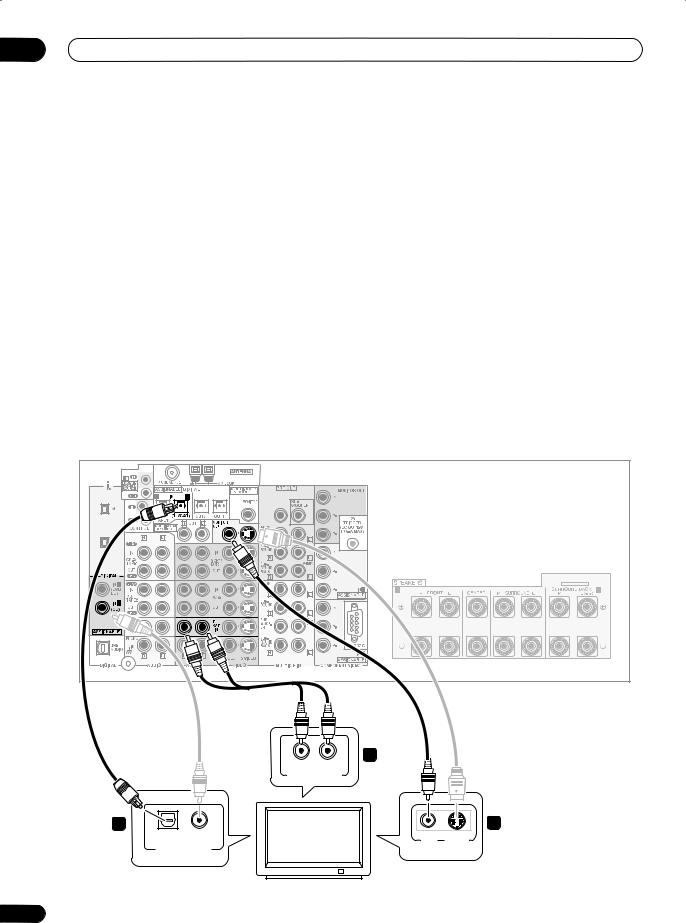
03 Connecting your equipment
Connecting your TV
This page shows you how to connect your TV to the receiver. To be able to play the sound from the TV’s builtin tuner, connect the analog audio outputs from your TV to this receiver.
If your TV has a built-in digital decoder, you can connect the digital audio output to this receiver to enjoy Dolby Digital and DTS sound from digital TV broadcasts.
1 Connect the MONITOR OUT video jack on this receiver to a video input on your TV.
Make sure you don’t connect to the MONITOR OUT connection for MULTI ROOM & SOURCE.
•You can use a standard RCA video cable to connect to the composite video jack, or for higher quality video, you can use an S-video cable to connect to the S-video jack (S-VIDEO).
•See Using the component video jacks on page 24 if you want to use the component video outputs to connect this receiver to your TV.
•See About the video converter on page 16 if you plan on connecting your other video components using different types of video cables than for your TV.
2Connect the analog audio outputs from your TV to the TV/SAT inputs on this receiver.
•Use a stereo RCA phono cable for the connection.
3Connect an optical digital audio output from your TV to the DIGITAL 1 (TV/SAT) input on this receiver.
•Use an optical cable for the connection.
•If your TV only has a coaxial digital output, you can connect it to one of the coaxial inputs on this receiver using a coaxial digital audio cable. When you set up the receiver you’ll need to tell the receiver which input you connected the TV to (see Assigning the digital inputs on page 81).
 Note
Note
•If your TV doesn’t have a digital audio output, omit step 3 above.
 CENTER
CENTER
S400
S400
SELECTABLE
VSX-AX5Ai
|
2 |
|
R |
L |
|
ANALOG AUDIO OUT |
|
|
3 |
|
1 |
OPTICAL COAXIAL |
VIDEO |
S-VIDEO |
DIGITAL AUDIO OUT |
IN |
IN |
|
|
|
TV
18
En
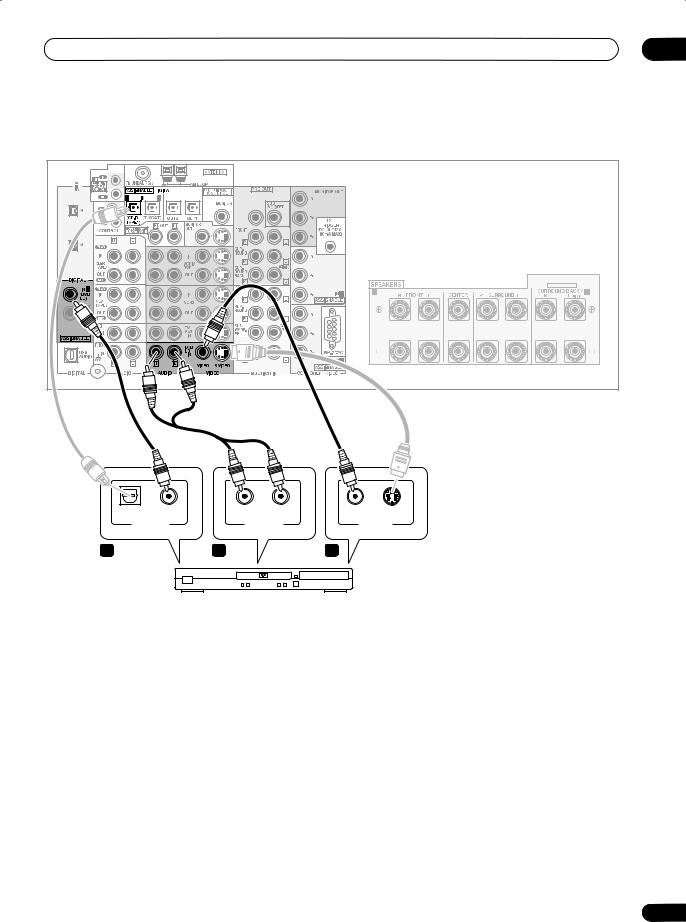
Connecting your equipment |
03 |
Connecting a DVD player
 CENTER
CENTER
S400
S400
SELECTABLE
VSX-AX5Ai
OPTICAL |
COAXIAL |
R AUDIO L |
S-VIDEO |
DIGITAL OUT |
ANALOG OUT |
VIDEO OUT |
|
1 |
|
2 |
3 |
DVD player
Different DVD players offer a different selection of connections, but all should give you at least a digital audio output, stereo analog audio outputs and a video output. Additionally, you may have a player with multichannel analog audio outputs and different kinds of video outputs to choose from.
1 Connect a coaxial digital audio output on your DVD player to the DIGITAL 3 (DVD/LD) input on this receiver.
•Use a coaxial digital audio cable for the connection.
•If your DVD player only has an optical digital output, you can connect it to one of the optical inputs on this receiver using an optical cable. When you set up the receiver you’ll need to tell the receiver which input you connected the player to (see Assigning the digital inputs on page 81).
2If your DVD player only has stereo analog audio outputs, connect these to the DVD/LD AUDIO inputs on this receiver.
•Use a stereo RCA phono cable for the connection.
•If your DVD player has multichannel analog outputs, see Connecting the multichannel analog outputs below for how to connect it.
3Connect a composite or S-video output on your DVD player to the DVD/LD VIDEO or DVD/LD S- VIDEO input on this receiver.
•Use a standard RCA video cable or an S-video cable for the connection.
•See About the video converter on page 16 if you plan to use a different type of video cable than you used to connect your TV.
•If your player also has a component video output, you can connect this too. See Using the component video jacks on page 24 for more on this.
19
En
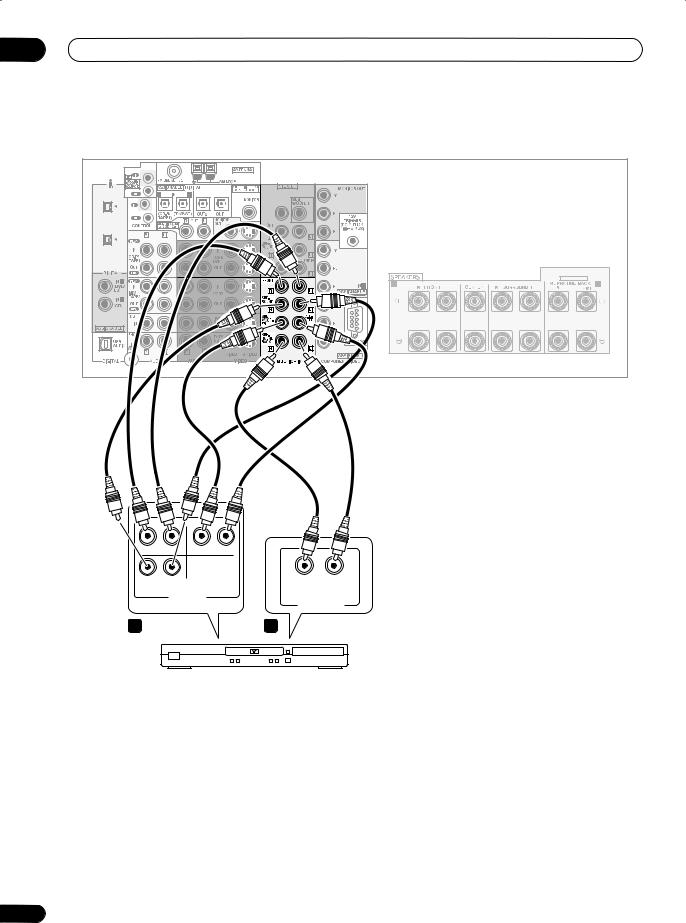
03 Connecting your equipment
Connecting the multichannel analog outputs
 CENTER
CENTER
S400
S400
R |
FRONT |
L |
SUB W. CENTER |
|
|
|
|
|
|
||
R |
SURR. |
L |
|
R |
L |
|
|
|
|
SURR. |
|
|
|
|
|
|
|
|
|
MULTI CH |
|
BACK |
|
|
|
|
|
||
|
|
OUTPUT |
|
MULTI CH. OUT |
|
1 |
|
|
|
2 |
|
DVD player
SELECTABLE
VSX-AX5Ai
For DVD Audio and SACD playback, your DVD player may have 5.1, 6.1 or 7.1 channel analog outputs (depending on whether your player supports surround back channels).
1 Connect the front, surround, center and subwoofer outputs on your DVD player to the corresponding MULTI CH IN jack on this receiver.
•Use standard RCA phono cables for the connections.
•Take care to connect each output to its corresponding input on the receiver.
2 If your DVD player also has outputs for surround back channels, connect these to the corresponding MULTI CH IN jacks on this receiver.
•Use standard RCA phono cables for the connections.
•If there is only a single surround back output, be sure to connect it to the SURROUND BACK L jack on this receiver.
 Note
Note
•To listen to multichannel analog audio you’ll need to press MULTI CH INPUT on the remote (see Using the multichannel analog inputs on page 42 for more on this).
20
En

Connecting your equipment |
03 |
Connecting a satellite/cable receiver or other set-top box
Satellite and cable receivers, and terrestrial digital TV tuners are all examples of so-called ‘set-top boxes’.
1Connect a set of audio/video outputs on the settop box component to the TV/SAT AUDIO and VIDEO inputs on this receiver.
•Use a stereo RCA phono cable for the audio connection and a standard RCA video or S-video cable for the video connection.
•See About the video converter on page 16 if you plan to use a different type of video cable than you used to connect your TV.
2Connect an optical digital audio output from your set-top box component to the DIGITAL 1 (TV/ SAT) input on this receiver.
•Use an optical cable for the connection.
•If your set-top box only has a coaxial digital output, you can connect it to one of the coaxial inputs on this receiver using a coaxial digital audio cable. When you set up the receiver you’ll need to tell the receiver which input you connected the set-top box to (see
Assigning the digital inputs on page 81).
 Note
Note
•If your satellite/cable receiver doesn’t have a digital audio output, omit step 2 above.
•If you’ve already connected your TV to the TV/SAT inputs above, simply choose another input. However, you’ll need to tell the receiver which input you connected the set-top box to (see Assigning the digital inputs on page 81).
 CENTER
CENTER
S400
S400
SELECTABLE
VSX-AX5Ai
2
DIGITAL OUT |
|
|
|
|
|
OPTICAL |
COAXIAL |
R |
AUDIO |
L |
VIDEO |
|
|
|
|
||
1
S-VIDEO
AV OUT
STB
21
En
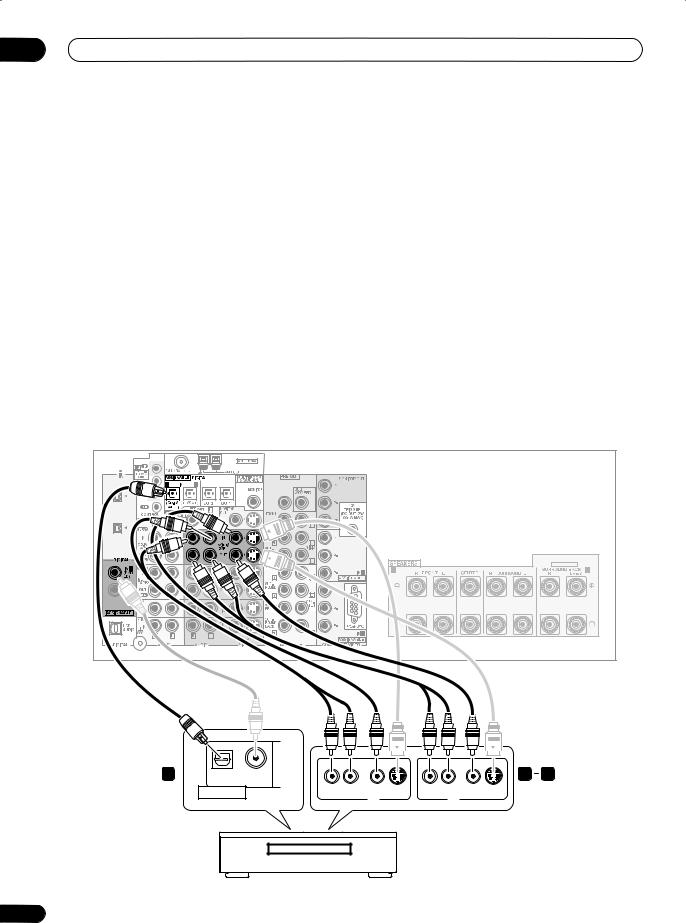
03 Connecting your equipment
Connecting a VCR or DVD recorder
This receiver has two sets of audio/video inputs and outputs suitable for connecting analog or digital video recorders, including VCRs, DVD-recorders and HDD recorders.
•See About the video converter on page 16 if you plan to use a different type of video cable than you used to connect your TV.
1Connect a set of audio/video outputs on the recorder to the VCR1/DVR AUDIO and VIDEO inputs on this receiver.
•Use a stereo RCA phono cable for the audio connection and a standard RCA video or S-video cable for the video connection.
•For a second recorder, use the VCR2 inputs.
2Connect a set of audio/video inputs on the recorder to the VCR1/DVR AUDIO and VIDEO outputs on this receiver.
•Use a stereo RCA phono cable for the audio connection and a standard RCA video or S-video cable for the video connection.
• For a second recorder, use the VCR2 outputs.
3 Connect an optical digital audio output from the recorder to a digital input on this receiver.
The example illustration below shows a recorder connected to the optical DIGITAL 2 (CD-R/TAPE1) input. When you set up the receiver you’ll need to tell the receiver which input you connected the recorder to (see
Assigning the digital inputs on page 81).
•Use a coaxial digital audio cable or an optical cable for the connection depending on the type of input you used.
•The digital outputs from another recorder can be connected to any spare digital audio input on this receiver. You can assign it when setting up the receiver (see Assigning the digital inputs on page 81).
 Note
Note
•If your video component doesn’t have a digital audio output, omit step 3 above.
 CENTER
CENTER
S400
S400
SELECTABLE
VSX-AX5Ai
3 |
OPTICAL |
COAXIAL |
|
DIGITAL OUT |
|
1 2
R AUDIO L |
VIDEO |
S-VIDEO |
R AUDIO L |
VIDEO |
S-VIDEO |
|
AV OUT |
|
|
AV IN |
|
DVR, VCR, etc.
22
En
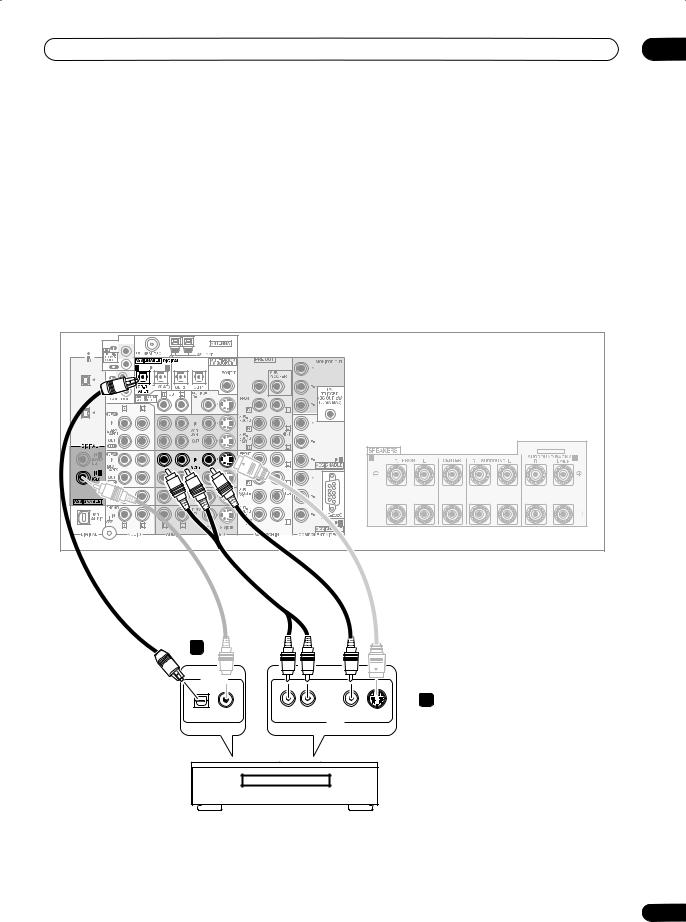
Connecting your equipment |
03 |
Connecting other video sources
You can basically use any of the audio/video inputs on this receiver for any kind of video source. The example illustration below shows a component connected to the VCR2 inputs.
1 Connect the analog audio outputs and a video output of the source component to a set of spare audio/video inputs on this receiver.
•Use a stereo RCA phono cable for the audio connection and a standard RCA video or S-video cable for the video connection.
•See About the video converter on page 16 if you plan to use a different type of video cable than you used to connect your TV.
2 If the source component has a digital audio output, connect it to a spare digital audio input on this receiver.
•Use a coaxial digital audio cable or an optical cable for the connection depending on the type of input you used.
•You may need to assign the digital input you used when setting up the receiver (see Assigning the digital inputs on page 81).
 CENTER
CENTER
S400
S400
SELECTABLE
VSX-AX5Ai
2
DIGITAL OUT 
OPTICAL |
COAXIAL |
R AUDIO L |
1
VIDEO S-VIDEO
AV OUT
LD player, video player, TV game, etc.
23
En
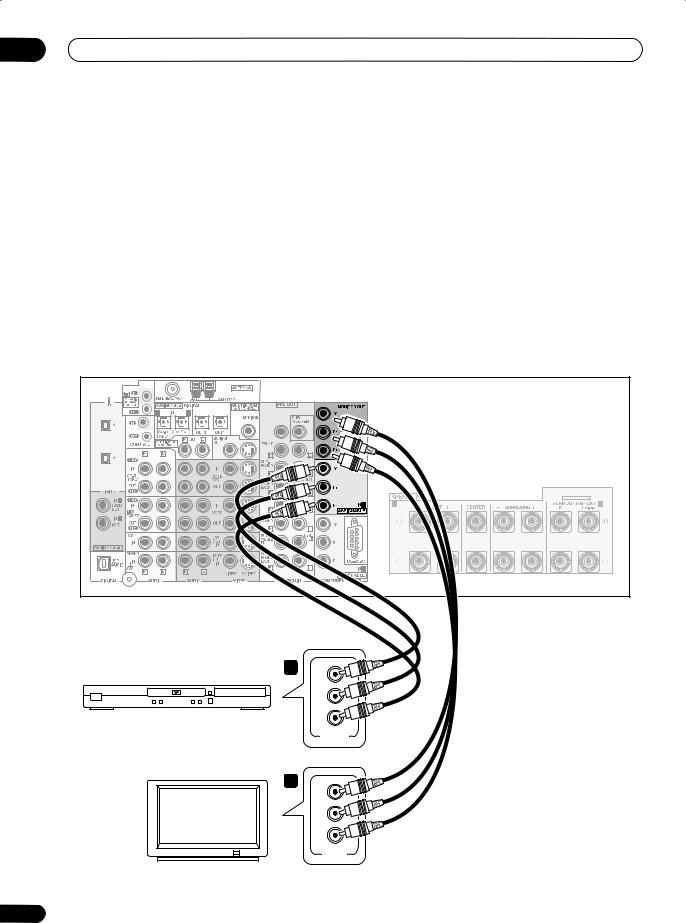
03 Connecting your equipment
Using the component video jacks
Component video should deliver superior picture quality when compared to composite or S-video. A further advantage (if your source and TV are both compatible) is progressive-scan video, which delivers a very stable, flicker-free picture. See the manuals that came with your TV and source component to check whether they are compatible with progressive-scan video.
 Important
Important
•If you connect any source component to the receiver using a component video input, you should also have your TV connected to this receiver's component video
MONITOR output.
1Connect the component video outputs of your source to a set of component video inputs on this receiver.
Use a three-way component video cable for the connection.
2Assign the component video inputs to the input source you’ve connected.
This must be done so that they can be used in conjunction with the audio/video input(s) to which you have connected the component above (see Assigning the component video inputs on page 82 for more on this).
3Connect the COMPONENT VIDEO MONITOR OUT jacks on this receiver to the component video inputs on your TV or monitor.
•Use a three-way component video cable.

 CENTER
CENTER
S400
S400
|
1 |
|
Y |
|
PB |
DVD player |
PR |
|
COMPONENT
VIDEO OUT
2
Y
PB
PR
COMPONENT
VIDEO IN
TV
SELECTABLE
VSX-AX5Ai
24
En
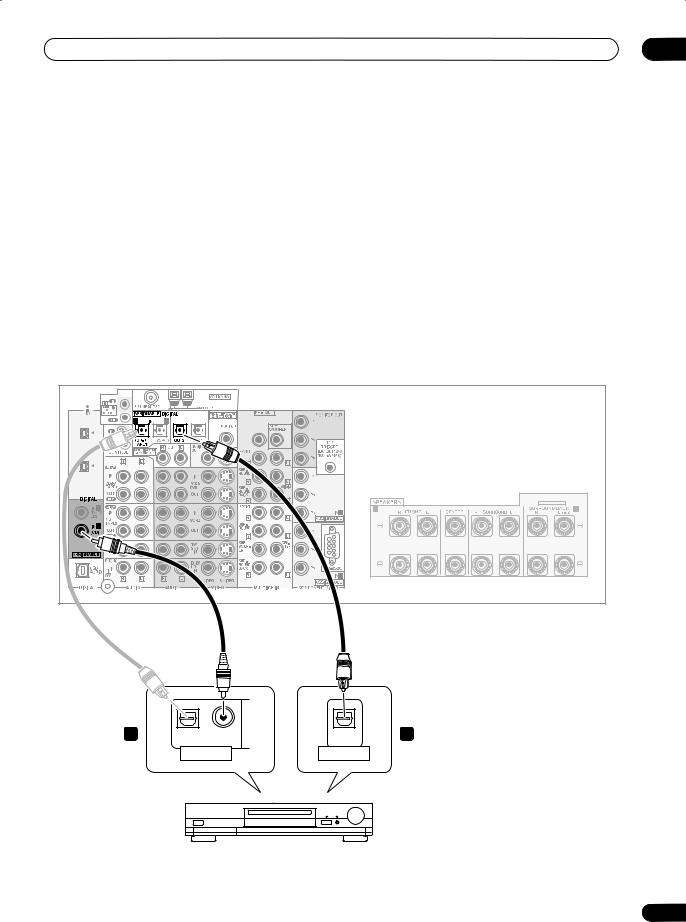
Connecting your equipment |
03 |
Connecting digital audio sources
This receiver has both digital inputs and outputs, allowing you to connect digital components for playback and for making digital recordings. Many digital components also have analog connections for recording analog sources (such as a turntable or tape deck). See
Connecting analog audio sources below for more on this.
1 Connect a coaxial digital output on your digital component to the DIGITAL 4 (CD) input on this receiver.
•Use a coaxial digital audio cable for the connection.
•If your digital component only has an optical digital output, you can connect it to one of the optical inputs on this receiver using an optical cable. When you set up the receiver you’ll need to tell the receiver which input you connected the player to (see Assigning the digital inputs on page 81).
•The digital outputs from other components can be connected to any spare digital audio inputs on this receiver. You can assign them when setting up the receiver (see Assigning the digital inputs on page 81).
2 Connect one of the DIGITAL outputs on this receiver to a digital input on the component.
•Use an optical cable to connect to the DIGITAL OUT1 or OUT2 (OUT2 is shown in the illustration below).
 Note
Note
•In order to record some digital sources, you must make analog connections as explained in Connecting analog audio sources below.
 CENTER
CENTER
S400
S400
SELECTABLE
VSX-AX5Ai
1 |
OPTICAL |
COAXIAL |
OPTICAL |
2 |
|
DIGITAL OUT |
DIGITAL IN |
|
|
CD-R, MD, DAT, etc.
25
En
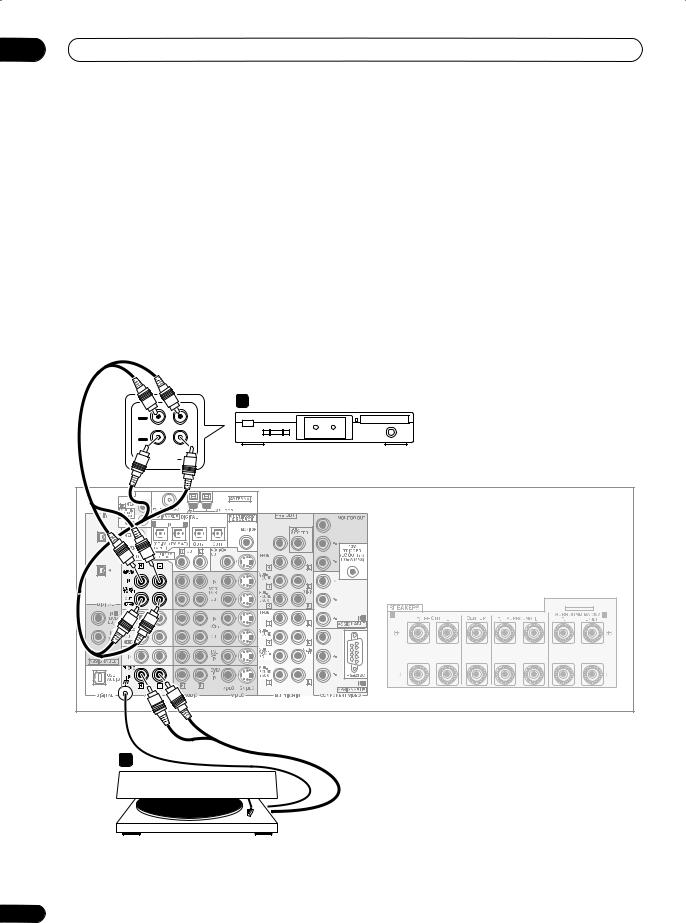
03 Connecting your equipment
Connecting analog audio sources
This receiver features four stereo audio-only inputs. Two of these inputs have corresponding outputs for use with audio recorders.
One of the audio inputs (PHONO) is a switchable turntable input which can also be used for line level components (see PHONO/LINE Setup on page 84 for more on this). This input also has a grounding terminal that most turntables require.
1 Connect the analog audio outputs of the source component to a set of spare audio inputs on this receiver.
•If you’re connecting a tape deck, MD recorder, etc., connect the analog audio outputs (REC) to the analog audio inputs on the recorder.
|
|
1 |
OUT |
|
|
PLAY |
|
|
IN |
|
|
REC |
|
|
R |
L |
Tape deck, etc. |
AUDIO IN/OUT |
|
|
|
|
• Use a stereo RCA phono cable for the connections.
2 Connect the stereo audio outputs of your turntable to the PHONO inputs on this receiver.
•If your turntable has a grounding wire, secure it to the ground terminal on this receiver.
•If your turntable has line-level outputs (no grounding wire), or if you want to connect a different line-level component, refer to PHONO/LINE Setup on page 84 to switch this input to the LINE setting.
 CENTER
CENTER
S400
S400
SELECTABLE
VSX-AX5Ai
2
Turntable
26
En

Connecting your equipment |
03 |
Connecting a component to the front panel inputs
The front panel inputs include a composite video jack (VIDEO), an S-video jack (S-VIDEO), stereo analog audio inputs (AUDIO L/R) and an optical digital audio input (DIGITAL). You can use these connections for any kind of audio/video component, but they are especially convenient for portable equipment such as camcorders, video games and portable audio/video equipment.
•The input signals can be accessed by selecting VIDEO as the input source.
•Pull down the front cover where indicated to access the front panel inputs.
•The illustration below shows example connections to a portable DVD player. Note that you may need a specialized optical cable for this connection.
VSX-AX5Ai |
COLOR |
BRIGHT |
MONITOR |
VIDEO IN/OUT |
AUDIO IN/OUT |
PHONES |
ON/OFF |
HOLD |
DIGITALOUT(OPTICAL)
Portable DVD player, etc.
27
En
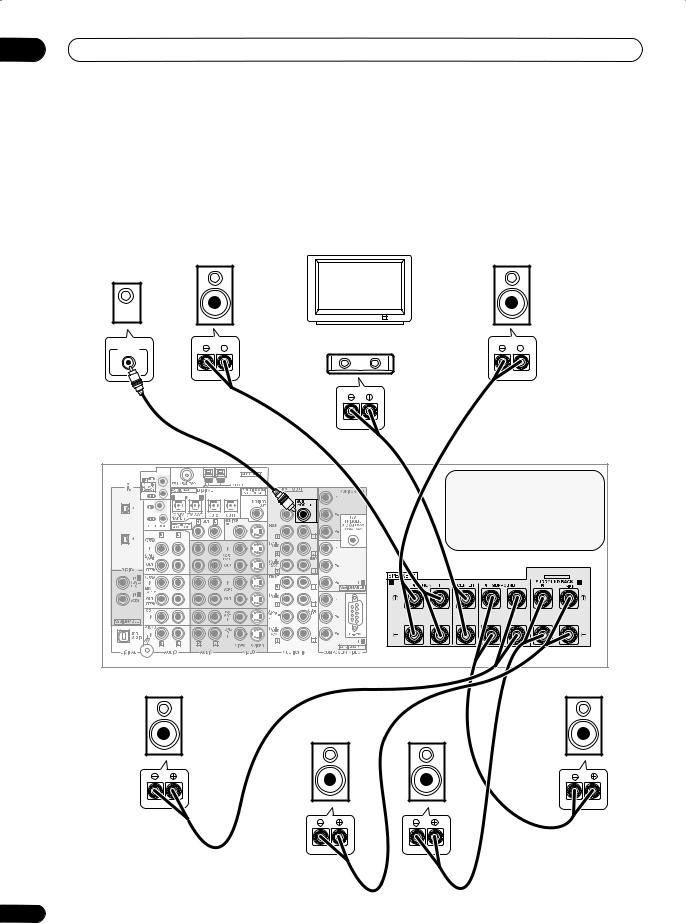
03 Connecting your equipment
Installing your speaker system
To take full advantage of the receiver’s surround sound capabilities connect front, center, surround and surround back speakers, as well as a subwoofer. Although this is ideal, other configurations with fewer speakers—no subwoofer or no center speaker, or even no surround speakers—will work. At the very least, front left and right speakers only are necessary. Note that your
main surround speakers should always be connected as a pair, but you can connect just one surround back speaker if you like (it must be connected to the left surround back terminal). You can use speakers with a nominal impedance between 6–16Ω (please see
Switching the speaker impedance on page 68 if you plan to use speakers with an impedance of less than 8Ω).
Subwoofer |
Front |
Front |
|
left |
right |
|
|
TV |
LINE LEVEL |
|
Center |
INPUT |
|
|
 Caution
Caution
These speaker terminals carry
HAZARDOUS LIVE voltage. To prevent
CENTER
the risk of electric shock when connecting
S400
or disconnecting the speaker cables,
disconnect the power cord before
touching any uninsulated parts.
S400
SELECTABLE
VSX-AX5Ai
Surround |
|
|
Surround |
left |
Surround |
Surround |
right |
|
back left |
back right |
|
28
En

Connecting your equipment
Connecting the speakers
Each speaker connection on the receiver comprises a positive (+) red, and negative (–) black terminal. For proper sound you should take care to match these up with the terminals on the speakers themselves.
•If you only have one surround back speaker, hook it up to the surround back left (Single) terminal.
 Caution
Caution
•Make sure that all the bare speaker wire is twisted together and inserted fully into the speaker terminal. If any of the bare speaker wire touches the back panel it may cause the power to cut off as a safety measure.
Bare wire connections
Before you start connecting the speakers, make sure that the speaker cable you’re going to use is properly prepared with about 10 mm of insulator stripped from each wire, and the exposed wire strands twisted together (fig. A).
To connect a terminal, unscrew the terminal a few turns until there is enough space to insert the exposed wire (fig. B). Once the wire is in position, tighten the terminal until the wire is firmly clamped (fig. C).
10mm
fig. A |
fig. B |
fig. C |
 Note
Note
•Please refer to the manual that came with your speakers for details on how to connect the other end of the speaker cables to your speakers.
•If you are using a THX certified subwoofer use the THX INPUT jack on the subwoofer (if your subwoofer has one) or switch the filter position to THX on your subwoofer.
•The surround speaker terminals on this receiver can be connected in a number of ways, depending on your setup. See Surround back speaker setting on page 55 for an overview of the possible configurations.
•Other connections on page 71 provides greater detail on alternate speaker setups such as using speaker system B (page 71) and bi-amping (page 72).
03
Placing the speakers
Where you put your speakers in the room has a big effect on the quality of the sound. The following guidelines should help you to get the best sound from your system.
•The subwoofer can be placed on the floor. Ideally, the other speakers should be at about ear-level when you’re listening to them. Putting the speakers on the floor (except the subwoofer), or mounting them very high on a wall is not recommended.
•For the best stereo effect, place the front speakers 2–3m apart, at equal distance from the TV.
•Install the center speaker above or below the TV so that the sound of the center channel is localized at the TV screen.
•When placing speakers near the TV, use magnetically shielded speakers to prevent possible interference, such as discoloration of the picture when the TV is switched on. If you do not have magnetically shielded speakers and notice discoloration of the TV picture, move the speakers farther away from the TV.
•If possible, install the surround speakers slightly above ear level.
•If you have two surround back speakers THX recommends placing them together and the same distance from your listening position.
Front L |
Front R |
Sub- |
|
woofer |
|
|
Center |
Surround |
Surround |
L |
R |
Surround |
Surround |
back L |
back R |
 Caution
Caution
•Make sure that all speakers are securely installed. This not only improves sound quality, but also reduces the risk of damage or injury resulting from speakers being knocked over or falling in the event of external shocks such as earthquakes.
29
En
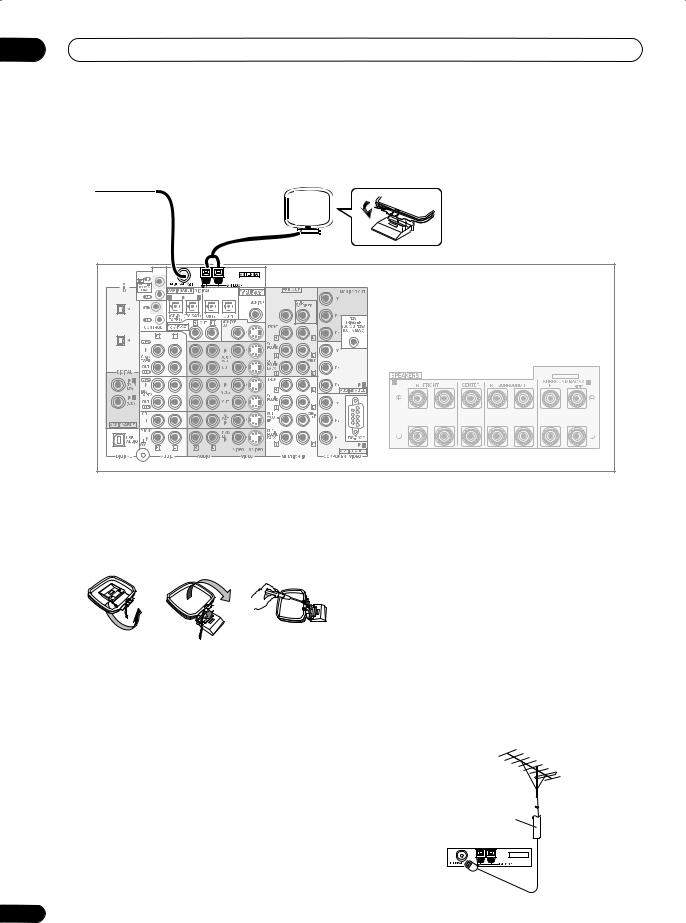
03 Connecting your equipment
Connecting antennas
The supplied antennas provide a simple way to listen to AM and FM radio. If you find that reception quality is poor, an outdoor antenna should give you better sound quality—see Connecting external antennas below.
FM wire antenna
AM loop antenna
 CENTER
CENTER
S400
S400
SELECTABLE
VSX-AX5Ai
AM loop antenna
1 Assemble the stand as shown in the illustration.
fig. A |
fig. B |
fig. C |
•Bend the stand in the direction indicated (fig. A).
•Clip the loop into the stand (fig. B).
•It’s possible to fix the AM antenna to a wall (fig. C). Before fixing, make sure that the reception is satisfactory.
2Pull off the protective shields of both AM antenna wires.
3Press the AM LOOP antenna terminal tabs to open and insert one wire into each terminal.
4Release the tabs to secure the AM antenna wires.
5Place the AM antenna on a flat surface and point in the direction giving the best reception.
Avoid placing near computers, television sets or other electrical appliances and do not let it come into contact with metal objects.
 Note
Note
•The signal ground ( ) is designed to reduce noise that occurs when an antenna is connected. It is not an electrical safety ground.
FM wire antenna
• Connect the FM wire antenna to the FM UNBAL 75Ω terminal.
For best results, extend the FM antenna fully and fix to a wall or door frame. Don’t drape loosely or leave coiled up.
Connecting external antennas
To improve FM reception connect an external FM antenna to the FM UNBAL 75Ω.
75Ω coaxial cable
ANTENNA
30
En
